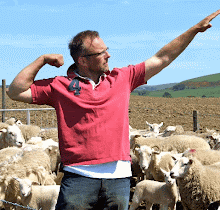Somewhere near Chandigarh, Punjab, India. Its Saturday. The group now numbers five ... we’re not exactly famous but at least three of us have had lashings and lashings of ginger beer the night before.
We take a walk through Chandigarh centre to experience the shabby madness that seems to be standard in India’s urban centres. James gets his shoes polished. I do too. James pays his polisher the equivalent of 20 times the normal rate .... everyone gets very excited ... a rather large and amused crowd has now gathered ... its all I can do to convince my man 7.5 times the correct rate is acceptable. I power walk ... hips wiggling vigourously ... away from the problem.
We are picked up by the sophisticated Kanwal. Tony - our glorious leader - had found his farm stay on the internet. It turns out its like some sort of cyber gold rush ... the guy is brilliant. We visit two dairy farms, inspect wheat and vegetables. The Punjab is India’s Japati basket. 44% of the grains (rice and wheat) produced in India are produced here ... on 2 % of the country’s farm land. Bare agricultural land values range from £30,000 to £60,000 per acre ... hope value (for future development) has a massive impact that drives up price even further. The Green Belt around Chandigarh can command up to $500 million for 1 acre.
Land in Punjab was subject to severe legislation after independance. The maximum holding any individual could own was set at 25 acres. This together with subsequent splits via inheritance means farms are small (90% of farms in all of India are 5 acres or less) ... yet 3 crops of maize a year is easy in Punjab, one guy reckoned 4 was possible. The first dairy farmer we meet tells how his grandfather dug a well in 1947 and only needed to go to 10 feet; his father then dug a well in 1962 and had to go deeper - 62 feet; then he himself had to dig a well in 2010 ... to get to water he had to bore to 500 feet. Such is the challenge in the Punjab ... what the weather giveth, the weather (and extreme irrigation) now taketh away. The significant move to dairy ... away from thirsty rice ... is a reaction to this challenge.
We meet the head of the village and all his family ... he has a big family. We drink sugar lightly diluted with warm buffalo milk. We drink tap water. We are an attraction. A child comes in and as if in awe of a deity, swiftly kneels to touch Rona’s sandals then quickly departs.
We return to Kanwal’s house and meet his father. He is a serene Sikh gentleman with a warm sense of humour. We learn much just talking to the father and son team. From their reading of my palm, I learn that I have had a midlife crisis and the future is not foretold ... I consider this does not represent new information. I then worry that there is no life after the mid life crisis thing and keep looking at my palm in case the line has formed yet. They both get very excited by James’s hand, its so unusual I think they might wet themselves in some sort of synchronised urination display. He is nicknamed golden hands for at least ten minutes.
We giggle on and off for another 24 hours ... we have deep debates ... we learn many new things about India and each other ... until on our last night we up the giggle intensity ... I giggle like I haven’t giggled for a long, long time. My stomach hurts as I go to bed - its a happy hurt ... though it still could be the tap water.











No comments:
Post a Comment